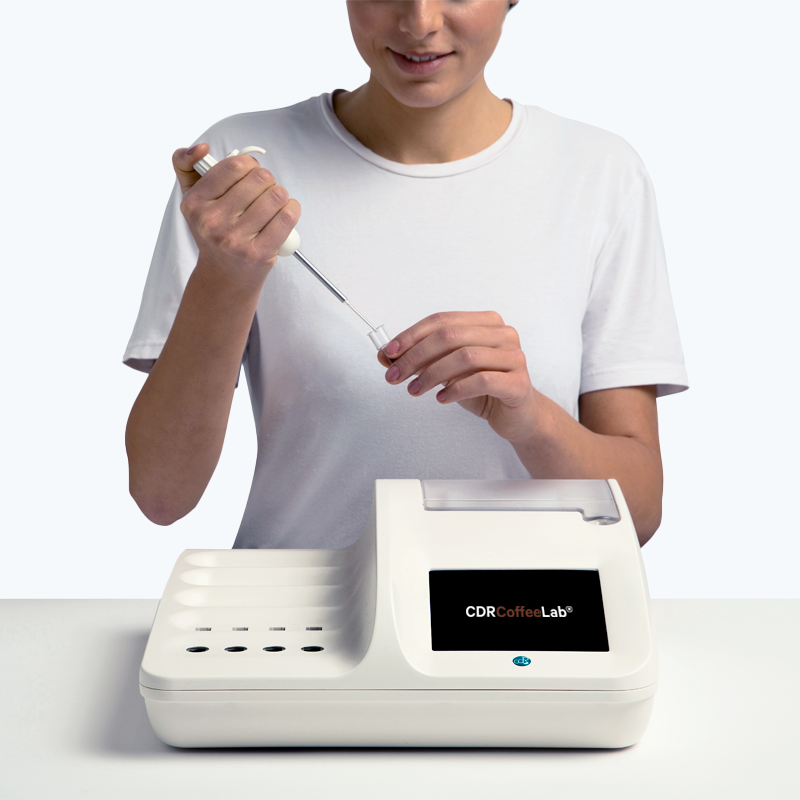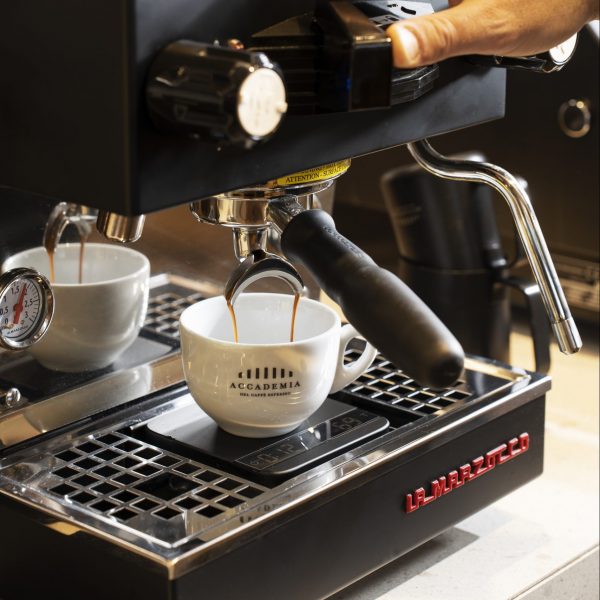Blog
Espresso, Filter Coffee, Cold Brew, French Press, or Moka: Which Has the Most Caffeine Content?
Sharing results of a Study Conducted at the Accademia del Caffè Espresso with CDR CoffeeLab®
There are many variables when talking about coffee, making it challenging to make a generic statement or rule. In this study, the Accademia del Caffè Espresso teamed up with CDR CoffeeLab® to closely examine the caffeine content of several coffee beverages brewed with different extraction methods. One reads so many different things about coffee and caffeine; the recommended maximum amount is 400mg of caffeine a day, which varies from person to person.
The aim of this study is to visualize how much caffeine you find in different common coffee beverages, considering that it always depends on which initial matter you are using and how you prepare it.
1 Arabica Coffee:
- Origin: Brazil Cerrado Mineiro
- Altitude: 950 masl
- Variety: Yellow Catuai
- Process: Natural
3 Different Roast Levels:
- Light roast
- Medium roast
- Dark roast
5 Different Brewing Methods:
- Espresso extracted with 9 bar
- Filter Coffee using the V60 dripper / gravitation method
- Filter Coffee using French press / full immersion method
- Moka
- Cold Brew using Toddy home unit / full immersion and gravitation
Does roasted coffee contain more caffeine than green coffee?
The level of caffeine contained in roasted coffee is greater than that found in green coffee beans. This increase is only apparent; in reality, the caffeine does not increase during the roasting process. During roasting, coffee loses moisture, thus increasing the amount of caffeine by weight. To confirm this hypothesis, after measuring the caffeine concentration in green coffee, the coffee was roasted with three different roast levels, and the theoretical caffeine content in the roasted coffee was calculated considering only the weight loss. Subsequently, the caffeine concentration in the roasted coffee was measured experimentally. The measured values and the calculated ones coincide, confirming the hypothesis: the darker the roast, the greater the moisture loss, and consequently, the higher the caffeine concentration.
| End temp °C | Roast time | Green weight | Roasted weight | Roast color ground | Weight loss | Caffeine: theoretical value | Caffeine: experimental value | |
| Green | 1.3% | |||||||
| Light roast | 209.6 | 09:02 | 3000 g | 2585 g | 104.9 | -13.80% | 1.4% | 1.4% |
| Medium roast | 215.4 | 10:11 | 3000 g | 2548 g | 85.9 | -15.00% | 1.4% | 1.4% |
| Dark roast | 235.1 | 11:05 | 3000 g | 2444 g | 54.0 | -18.50% | 1.5% | 1.5% |
Table 1: Roasting Information
Figure 1: Variation of caffeine concentration with different roasting levels
How much caffeine is in a cup of coffee?
| Cup | Brew ratio | |
| Espresso | 30 ml | 1:2 |
| Filter coffee | 150 ml | 1:17 |
| French press | 150 ml | 1:17 |
| Moka | 50 ml | 1:8 |
| Cold Brew ready to drink | 150 ml | 1:14 |
| Cold Brew concentrate | 30 ml | 1:4 |
Table 2: Brew ratio and coffee volumes considered for each extraction method. These volumes were used in the caffeine calculation for each cup.
Knowing the amount of caffeine you consume by drinking coffee is not that simple because the concentration in a cup depends on many variables. The variety of coffee used and its origin are fundamental. The Arabica and Robusta varieties are numerous, and each has a different amount of caffeine inside. Even using the same starting product, the amounts of caffeine we find in the beverage can be very different depending on the extraction method chosen, the brew ratio, and the degree of roasting of the beans.
In this study, 18 coffees were analyzed. All were obtained using the same green coffee but with three different roast levels and six different extraction methods. In Figure 2, you can see the amount of caffeine measured in the different beverages with various roast levels (the coffee volumes associated with these beverages are reported in Table 2).
Figure 2: mg of caffeine analyzed in different beverages
Espresso is the preparation method that concentrates not only the aromas and sensory characteristics but also the caffeine. In the case of espresso (30 ml, with a brew ratio of 1:2), we obtained amounts exceeding 120 mg of caffeine per coffee, values up to six times higher than a cup (150 ml) of filter coffee. Similar results to filter coffee were obtained with the French Press, while higher values were recorded with the Moka.
Special attention to cold brew coffee. This cold-extracted beverage can be obtained in various ways: by percolation/dripping or by infusion with cold or room temperature water and with more or less prolonged times (from 6 to 12 or even more hours) and with different brew ratios. In this study, we used the Toddy® Home Cold Brew System with an infusion time of 6 hours and two different brew ratios: a more concentrated one with a ratio of 250 g of coffee in 1 liter of water and a more diluted one (ready to drink: 60 g of coffee in 1 liter of water). The caffeine amount in the cold brew ready to drink is comparable to that of filter coffee due to the similar brew ratio and beverage volume. The caffeine extraction in the case of cold brew occurs thanks to the prolonged contact time between the coffee and water at a temperature of 20-25°C, resulting in a higher concentration of this substance in the final beverage than in filter coffee, where the extraction temperature is higher but the contact time is shorter.
For the cold brew ready to drink, we considered a 150 ml cup of beverage, while for the cold brew concentrate, a 30 ml cup which can then be further diluted with ice, milk, or plain cold water. Therefore, the calculated caffeine values are similar to the cold brew ready to drink.
Does a more roasted coffee have more caffeine?
With a darker roast, the percentage of caffeine in the beans increases slightly by weight, but the caffeine differences measured in light and dark roasted coffee do not justify the differences found in beverages. Furthermore, in the case of filter coffee, the increasing trend of caffeine values in beverages obtained with the same extraction method but different roasting levels (from light to dark) is not observed.
In a dark roasted coffee, there will be more caffeine available for extraction, but it is not certain that the extraction method used can extract all the caffeine present in the ground beans. Surely, the contact time between water and coffee and the water temperature during coffee preparation influence the amount of caffeine that will be in the beverage. The water passes through the coffee with more or less difficulty, determining a greater or lesser concentration of caffeine in the beverage obtained.
This explains why we find an anomalous trend of caffeine concentration in the case of filter coffee. This extraction method turns out to be less efficient than the others examined in this study, justifying the variable trend of caffeine concentrations found in the different prepared coffees. If the extraction percentages are calculated (mg caffeine in the beverage / mg of caffeine present in the coffee), the Moka turns out to be the method that can most effectively extract the caffeine present in the coffee beans. Thanks to the water temperature of over 90°C and the extraction time, this extraction method is particularly efficient in extracting caffeine. Despite this, due to the much lower brew ratio than espresso, the Moka coffee cups have resulted in a lower caffeine concentration than espresso.
In Figure 3, it is shown how the caffeine concentrations in the beverage and the TDS (Total Dissolved Solids) are connected, emphasizing the importance of extraction in caffeine concentration. Obviously, the values do not completely coincide because the TDS also includes other substances not proportional to caffeine.
Figure 3: Variation of mg of caffeine and TDS in different beverages
In general, it can be stated that you consume a greater amount of caffeine when using a dark roast coffee. However, the reason is not linked to the coffee itself but to the extraction that is more efficient in dark roasted coffee.
About Accademia del Caffè Espresso: Housed in the old La Marzocco factory, Accademia del Caffè Espresso is a cultural hub focused on understanding and promoting espresso. Today Accademia contains La Marzocco’s corporate museum and historical archive, an indoor coffee plantation, research and education laboratories, and the Officine Fratelli Bambi – a workshop dedicated to the craftsmanship and artistry, producing bespoke espresso machines.
CDR CoffeeLab® is a product of the CDR FoodLab® line by CDR – www.cdrfoodlab.com
About CDR: With its product line called CDR FoodLab®, CDR is a leading provider of innovative analysis systems for the food and beverage industry. Its solutions help professionals in the food industry improve quality control and optimize production processes. With a strong focus on research and development, CDR FoodLab® continues to introduce tailored, innovative technologies to meet the specific needs of various sectors within the food and beverage industry.




